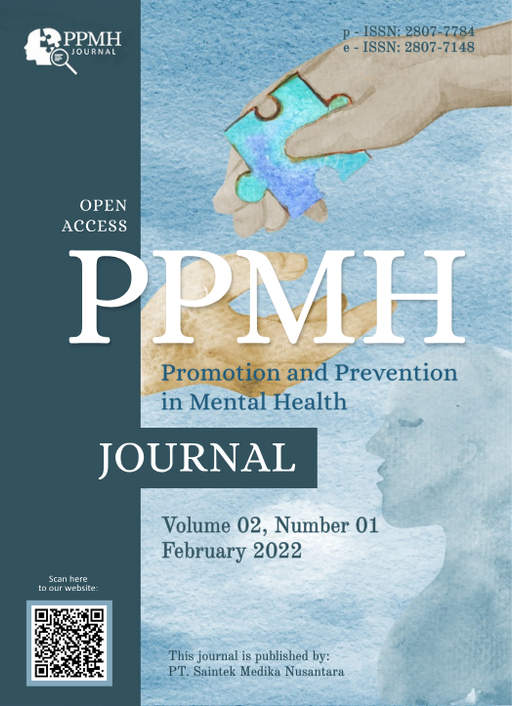Abstract
Suicide behavior in adolescents is a global phenomenon in all countries. Family is a causal factor and a protective factor for suicidal behavior in adolescents so that therapy given to adolescents with suicidal behavior must involve the family. This systematic review aimed to determine what family-based therapy can be given to adolescents with suicidal behavior. Systematic review began by identifying research articles in two databases, Proquest and EBSCO, 2013 – 2018, with predetermined keywords. The articles obtained were selected according to the inclusion and exclusion criteria specified. Five articles matched the inclusion and exclusion criteria. Based on the analysis results, family therapy for adolescents with suicidal behavior can be grouped based on providing educational information and parenting strategies, changing behavior, increasing family attachment, and preventing suicide in adolescents. Several therapeutic methods can be given to families who have teenagers with suicidal behavior. This article can be a reference in providing family-based therapy for adolescents with suicidal behavior.
References
Effendi F, Makhfudli. Keperawatan kesehatan komunitas : Teori dan Praktik dalam Keperawatan. Jakarta: Salemba Medika; 2009. 378 p.
WHO. Adolescents and mental health [Internet]. Maternal, newborn, child and adolescent health. 2017 [cited 2020 Feb 28]. Available from: https://www.who.int/maternal_child_adolescent/topics/adolescence/mental_health/en/#:~:text=Worldwide 10-20%25 of children,young people in all regions.
Riyadi S, Teguh P. Asuhan keperawatan jiwa. 1st ed. Yogyakarta: Graha Ilmu; 2009. 228 p.
Yosep I. Keperawatan Jiwa. 1st ed. Bandung: Refika Aditama; 2007.
Nandini N, Chaube N, Dahiya MS. Psychological review of suicide stories of celebrities: The distress behind contentment. Indian J Heal Wellbeing. 2018;9(2):280–5.
Todeshkchuei GG, Molaeinezhad M, Todeshkchuei SG. Psychosocial Factors Associated with Suicidal Behavior among Iranian Women: A Meta‑analysis. Adv Biomed Res. 2019;7(1):8.
Chan YY, Lim KH, Teh CH, Kee CC, Ghazali SM, Lim KK, et al. Prevalence and risk factors associated with suicidal ideation among adolescents in Malaysia. Int J Adolesc Med Health. 2018;30(3).
Huang Y, Li P, Guo L, Gao X, Xu Y, Huang G, et al. Sexual minority status and suicidal behaviour among Chinese adolescents: A nationally representative cross-sectional study. BMJ Open. 2018;8(8):1–10.
Stuart G. Prinsip dan praktik keperawatan jiwa Stuart (terjemahan) Jilid 1 & 2. Singapore: Elsevier; 2016.
Valdez-Santiago R, Solórzano EH, Iñiguez MM, Burgos LÁ, Gómez Hernández H, Martínez González Á. Attempted suicide among adolescents in Mexico: Prevalence and associated factors at the national level. Inj Prev. 2018;24(4):256–61.
WHO. Fact Sheets : Suicide [Internet]. 2019 [cited 2019 Apr 11]. Available from: http://www.who.int/en/news-room/fact-sheets/detail/suicide
Asarnow JR, Berk M, Hughes JL, Anderson NL. The SAFETY Program: A Treatment-Development Trial of a Cognitive-Behavioral Family Treatment for Adolescent Suicide Attempters. J Clin Child Adolesc Psychol. 2015;44(1):194–203.
Poole LA, Lewis AJ, Toumbourou JW, Knight T, Bertino MD, Pryor R. A Multi-Family Group Intervention for Adolescent Depression: The BEST MOOD Program. Fam Process. 2017;56(2):317–30.
Ewing ESK, Levy SA, Boamah-Wiafe L, Kobak R, Diamond G. Attachment-Based Family Therapy With a 13-Year-Old Girl Presenting With High Risk for Suicide. J Marital Fam Ther. 2016;42(1):91–105.
Hunt Q, Sandoval-Barrett J, Diamond G. Attachment-Based Family Therapy with Suicidal Adolescents: An Overview. Psychiatr Ann. 2017;47(8):412–5.
Kourgiantakis T, Ashcroft R. Family-focused practices in addictions: A scoping review protocol. BMJ Open. 2018;8(1):1–5.
Frey LM, Hunt QA. Treatment For Suicidal Thoughts and Behavior: A Review of Family-Based Interventions. J Marital Fam Ther. 2018;44(1):107–24.
Melton RP, Dykeman C. Family Aided Community Treatment for the Treatment of Early Psychosis: A Proof of Concept Study. Community Ment Health J. 2016;52(6):623–30.
McFarlane WR. Multifamily groups in the treatment of severe psychiatric disorders. New York: Guilford; 2002.
McFarlane W, Cook W, Downing D, Verdi M, Woodberry K, Ruff A. Portland Identification and Early Referral: A Community-Based System for Identifying and Treating Youths at High Risk of Psychosis. Psychiatr Serv. 2010;61(5):512–5.
Dimitropoulos G, Landers AL, Freeman VE, Novick J, Cullen O, Engelberg M, et al. Family-based treatment for transition age youth: Parental self-efficacy and caregiver accommodation. J Eat Disord. 2018;6(1):1–12.
Bühren K, Schwarte R, Fluck F, Timmesfeld N, Krei M, Egberts K, et al. Comorbid psychiatric disorders in female adolescents with first-onset anorexia nervosa. Eur Eat Disord Rev. 2014;22(1):39–44.
Singer JB, O’Brien KHMM, LeCloux M. Three Psychotherapies for Suicidal Adolescents: Overview of Conceptual Frameworks and Intervention Techniques. Child Adolesc Soc Work J. 2017;34(2):95–106.
